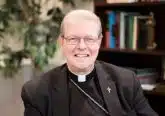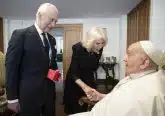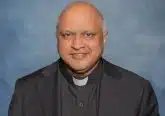As marriage rates continue to plunge, how can the Church get more people to the altar?
CNA Staff, Jul 11, 2024 / 06:00 am
The Catholic Church needs to be focused at the parish level to drive up plunging marriage rates among the faithful, experts say, as low marriage rates in the Church mirror the collapse of matrimony in wider society.
Catholic marriage rates dropped by about 70% between 1969 and 2019, according to data from Georgetown University’s Center for Applied Research in the Apostolate.
The collapse reflects the broader decline of marriage rates throughout the United States, with a record 25% of 40-year-olds in the U.S. currently having never been married, according to Pew Research data.
Experts and marriage advocates have long offered explanations for plummeting marriage rates. Mary Rose Verret, who with her husband, Ryan, founded the marriage renewal and preparation initiative Witness to Love, has argued that young Catholics are “not seeing holy, healthy, happy marriages being lived out,” leaving them without meaningful examples of successful unions.
The Verrets told CNA that the Catholic Church should be considerably more proactive in encouraging marriages.
“As a Church, we can do a better job talking about marriage from the pulpit,” Mary Rose said. “We need to talk to young people about marriage when they’re younger. We need to sing the benefits of marriage. We should have married couples go to schools and espouse the benefits of marriage.”
Ryan told CNA that such witness is a critical component to bolstering marriages, especially for those who lack those examples in their own lives. “How do you know there’s another way of doing things if you don’t even see it?” he said.
‘An opportunity for conversion’
Pope Francis last year named the Verrets as consultants to the Vatican’s Dicastery for the Laity, Family, and Life, which Mary Rose said would allow them to “serve the sacrament of marriage in a more impactful way.”
The couple’s Witness to Love program offers a “full-circle” approach to promoting strong marriages in order to counteract collapsing marriage numbers in the U.S. The ministry helps couples “explore the depths of their relationship” by “nurturing qualities that form the foundation of enduring love and commitment.”
Yet Ryan told CNA this week that “more and more couples these days don’t know someone who’s married.”
J.P. De Gance, the founder and president of a marriage and relationship ministry called Communio, pointed out that dioceses often invest much more in priestly vocations than matrimonial ones.
“Every diocese has a vocations director, and that director typically focuses on vocations to priestly ordination,” he told CNA. “When we focus in that area, we’re trying to get men to commit to a celibate life dedicated to Our Lord and to priestly ministry.”
“That’s a harder ask, typically, than marriage,” he pointed out. “… If you compare marital vocations to priestly vocations, ordinations are down 38% since 1970, but Catholic marriages are down north of 70%.”
That ratio, he said, means that “we’re getting twice as many priestly ordinations per Catholic wedding.”
He pointed out that historically marriage has been seen as the “foundation” of success, whereas in the modern era it is increasingly seen as a “capstone” to success.
“Today a lot of parents, even faithful parents, are saying: ‘Don’t think about getting married or even getting serious until after college. Wait until you’re established’,” DeGance noted. “Any time parents say that, you’re advancing a message that causes our kids to delay marriage.”
Parishes have a significant role to play in helping reverse this decline, De Gance said.
“At the parish level, we need to teach the skills of discerning a good Christian relationship and a good Christian spouse,” he said.
Though not everyone is called to marriage, De Gance said, pastors should stress that it’s “the most common path to grow in holiness.”
“A lot of time parish priests are concerned about preaching in this way,” he said. “They’re afraid of hurting people by talking about this.”
But “if we fail to preach and teach about it, we’re not going to have any chance to push back against the zeitgeist that’s saying the exact opposite,” he said.
Mary Rose Verret told CNA that she has observed intense interest from young people about marriage. When she facilitated marriage-focused events while working for the Family Life Office of the Diocese of Arlington, Virginia, “we’d hit the capacity of the building,” she said.
“It’s not that young people value marriage less,” she said. Rather, “they idealize it, they delay it,” and, further, they “don’t surround themselves with marriageable people.”
Ryan Verret said parishes should help facilitate relationships in which young adults can help each other toward getting married, including introducing single friends who are seeking marriage.
“We’re helping parishes to say: ‘If you want engaged couples to be married in the Church, then there needs to be an opportunity to enrich marriages,’” he said. To get to that point, he noted, young men and women “need to have a reference point for what marriage looks like in society.”
De Gance, meanwhile, said one way parishes can help is to defray the high costs often associated with weddings. The average wedding in the U.S. can run more than $30,000, which is often prohibitive for young people looking to get married.
Parishes often charge money for wedding services, including receptions, and De Gance said they should aim to keep those fees as low as possible.
“Parishes should see marriages and weddings as an opportunity for conversion, not as a way to offset costs for the parish,” he said. “The cost of a wedding is a barrier for a lot of young people. There should be inexpensive ways to leverage the facility so you can host a low-cost wedding reception.”
Part of the danger, De Gance noted, is that many Church leaders have become used to the new paradigm of low marriage rates and young people who don’t want to get married. “There is a general cultural zeitgeist that Catholics and other Christians have imbibed, and we don’t even realize it.”
Yet the crisis, he said, should not be overlooked. “This is the civilizational challenge facing the Church,” he said.













